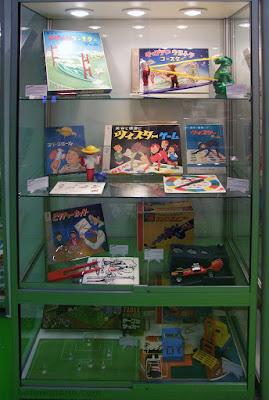In the first part of my Gamescom 2015 report I covered the preparations leading up to the event.
In today's post I will take you on a tour of the beforemario exhibition that was part of this huge five-day video gaming show that took place in August of this year.
I was assigned a nice area with ten glass cabinets, in the middle of the retro game section just behind the stage.
The area was open on both sides, allowing visitors to flow through.
Even though this was considerable space, it would be impossible to display my entire collection here, so I had to make a selection.
I made a cross selection of toys and games from Nintendo's history up to the Famicom era, showing the breadth of products they created from their start in 1889 up to around 1983-1985.
The exhibition also offered me an opportunity to promote my book to a wider audience and meet some readers who previously purchased it.
The cabinets showed Nintendo's history in chronological order, starting with their first product: playing cards.
Throughout their long history, Nintendo has produced many hundreds, if not thousands, different playing card sets. The first cabinet showed a selection of these; from very early (and thus very old) traditional Japanese cards up to more modern sets.
It is hard to imagine, given Nintendo's current company image, but they even produced some naughty cards back in the 1960s and 1970s.
The next cabinet showed board games and puzzles.
Nintendo released three different 3D puzzles, all of which were on display, including the Challenge Dice and the very rare Crossover.
Nintendo first global sales hit was the Ten Billion puzzle from 1980.
The third and fourth cabinet showed Nintendo's first plastic toys, like the Rabbit Coaster and Captain Ultra Coaster, as well as licensed games Twister and Mach Rider (not to be confused with the Famicom/NES game of the same name).
Also on display, of course, were Nintendo's toy trinity: the Ultra Hand, Ultra Machine and Ultra Scope.
All three were designed by Gunpei Yokoi, the game designer who, with the Ultra Hand, gave Nintendo its first million seller in Japan in 1966.
Electronics gradually started playing a more important role in Nintendo's toys from the second half of the 1960s, and the next cabinet showed some examples of these, including the 1969 Love Tester dating gimmick, the 1971 Eleconga electronic drum machine and the Light Telephone from 1972.
The oldest of Nintendo's electronic toys is the Companion walkie-talkie set from around 1965, which was manufactured by Sharp.
Cabinet number six presented a selection of building sets from Nintendo's N&B Block range.
These sets were, obviously, inspired by LEGO building blocks. Nintendo successfully competed against LEGO in Japan from 1968 to 1972, but they stopped this product line due to increasing legal pressure from the Danish firm.
Next up are Nintendo's light gun games from the Kôsenjû SP and Kôsenjû Custom series, which were released in the first half of the 1970s, as well as the 1976 Kôsenjû Duck Hunt.
This series includes many original targets, like a a collapsing cowboy and a poker game with spinning cards that are triggered when hit by the light from the light gun.
The final three cabinets showed the start of the home console era, beginning with the Color TV Game series with four models dating from 1977 to 1979.
Although the name of the 1980 Computer TV Game is very generic, it could only play a single game: Othello.
Around the same time Nintendo also introduced its line of hand held games, named Game & Watch.
Fifty-nine different Game & Watch games were produced over the years. Many of these were very successful, selling millions of copies around the world.
The entire series was on display, all equipped with fresh batteries and working.
The final cabinet was dedicated to the Family Computer, or Famicom for short.
Besides this landmark console itself, many of its accessories were included in the exhibition.
Nintendo's toy heritage clearly shines through in my personal favourite: the Family Computer Robot (also known as R.O.B. or Robotic Operating Buddy).
The Famicom had a number of advanced accessories that never made it outside of Japan, were the system was released as the Nintendo Entertainment System, including the Family Basic home computer extension and the Family Computer Network System with modem and online services, launched in
The Family Computer Disk System offered games on rewritable disks, similar to computer floppy disks.
The Famicom was a huge global success. At this time, almost a hundred years had passed since Nintendo was founded as a small local card manufacturer. I hope the beforemario exhibition showed the remarkable transformation the company has made during that period.
You can read part one of the beforemario Gamescom report here. This final part can be found here.

































No comments:
Post a Comment